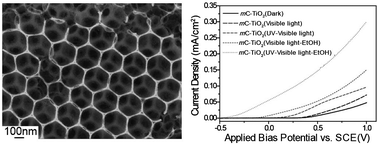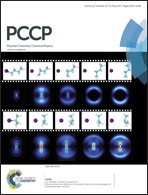Soft-template-carbonization route to highly textured mesoporous carbon–TiO2 inverse opals for efficient photocatalytic and photoelectrochemical applications†
Abstract
Hierarchically organized mesoporous carbon–TiO2 inverse opal nanostructures were synthesized by complementary colloid and block copolymer (BCP) self-assembly, where the triblock copolymer P123 acts simultaneously as the template and the carbon source. Highly ordered mesoporous inverse opal nanostructures with a nano-textured surface morphology and multiple-length scale nanopores provide increased light-activated surface area and scattering effects, leading to enhanced photoabsorption efficiency and the transport of matter. UV-vis absorption, X-ray photoelectron spectroscopy and Mott–Schottky measurement studies show that incorporation of carbon moieties into TiO2via direct conversion of BCPs creates a new energy level above the valence band of TiO2, resulting in an effective decrease in the band gap. A significantly enhanced visible light photocatalytic activity was demonstrated for the mesoporous carbon–TiO2 inverse opals in terms of the degradation of p-nitrophenol (∼79%) and photoelectrochemical water splitting (∼0.087%).


 Please wait while we load your content...
Please wait while we load your content...